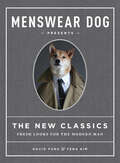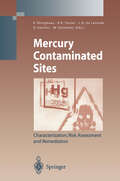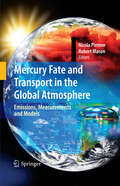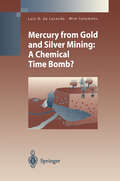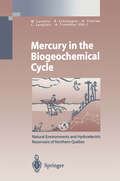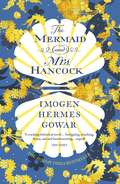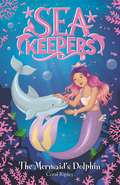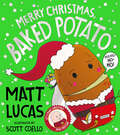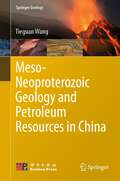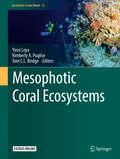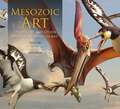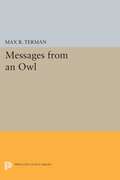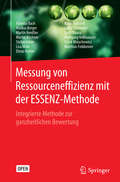- Table View
- List View
Menswear Dog Presents the New Classics: Fresh Looks for the Modern Man
by David Fung Yena KimBodhi, the Shiba Inu behind the beloved blog Menswear Dog, is here to show you how to dress like a man. Organized seasonally, The New Classics highlights the timeless, can&’t-go-wrong items every man needs in his wardrobe—from a chambray shirt to a perfectly fitted peacoat (all modeled by Bodhi, of course)—and shows how to mix and match them all year long. Whatever your style dilemma, dog&’s got your back! Readers will learn what to wear to a summer wedding, when to splurge (on the perfect white dress shirt) and when to save (snag your military field jacket at a thrift store), the secrets to getting the right fit, the brands that stand the test of time, the basics of clothing care, and more.
Mercury Contaminated Sites: Characterization, Risk Assessment and Remediation (Environmental Science and Engineering)
by Ralf Ebinghaus Ralph R. Turner Luiz D. De Lacerda O. Vasiliev Wim SalomonsAn up-to-date overview of the characterization, risk assessment and remediation of mercury-contaminated sites. The book summarizes, for the first time, works from Europe, Russia and the American continent, and review chapters are supplemented by detailed, international case studies.
Mercury Fate and Transport in the Global Atmosphere: Emissions, Measurements and Models
by Nicola Pirrone Robert MasonMercury, primarily because of its existence and bioaccumulation as methylmercury in aquatic organisms, is a concern for the health of higher trophic level organisms, or to their consumers. This is the major factor driving current research in mercury globally and in environmental regulation, and is the driver for the current UNEP Global Partnership for Mercury Transport and Fate Research (UNEP F&T) initiative. The overall focus of the UNEP F&T report is to assess the relative importance of different processes/mechanisms affecting the transfer of mercury (Hg) from emission sources to aquatic and terrestrial receptors and provide possible source-receptor relationships. This transfer occurs through atmospheric transport, chemical transformations and subsequent deposition, and involves the intermittent recycling between reservoirs that occurs prior to ultimate removal of Hg from the atmosphere. Understanding the sources, the global Hg transport and fate, and the impact of human activity on the biosphere, requires improved knowledge of Hg movement and transformation in the atmosphere. An improved understanding of Hg emission sources, fate and transport is important if there is to be a focused and concerted effort to set priorities and goals for Hg emission management and reduction at the national, regional and global levels; and to develop and implement such policies and strategies. To achieve this, a series of coordinated scientific endeavors focused on the estimation of sources, measurement and validation of concentrations and processes, and modeling, coupled with interpretation of the results within a policy framework, is likely to be required.
Mercury from Gold and Silver Mining: A Chemical Time Bomb? (Environmental Science and Engineering)
by Luiz D.de Lacerda Wim SalomonsDue to its inherent characteristics, mercury contamination from gold mining is a major environmental problem compared to past mercury contamination from industrial point sources. The worsening of social-economical conditions and increasing gold prices in the late 1970s resulted in a new rush for gold by individual entrepreneurs for whom Hg amalgamation is a cheap and easily carried out operation. Even after the present-day mining areas are exhausted, the mercury left behind will remain part of the biochemical cycle of the tropical forest. This book reviews the current information on mercury from gold mining, its cycling in the environment and its long-term ecotoxicological impact. The book is illustrated with numerous diagrams and photographs.
Mercury in the Biogeochemical Cycle: Natural Environments and Hydroelectric Reservoirs of Northern Québec (Canada) (Environmental Science and Engineering)
by AlainTremblay ClaudeLanglois NormandThérien RogerSchetagne MarcLucotteNowadays, major environmental issues are the object of large public debates de spite the fact that scientific knowledge is often insufficient to draw unequivocal conclusions. Such is the case in the ongoing debate regarding the specific contri butions of anthropogenic greenhouse gas emissions and of natural climate changes to global warming. At least 10 to 20 years of additional observations will be re quired, before we will be able to conclude, with certainty, on this subject. In the mean time, and as directed by their immediate interests, people will continue to promote contradictory opinions. The media are, in part, responsible for perpetuat ing such debates in that they convey indiscriminately the opinion of highly credi ble scientists as that of dogmatic researchers, the latter, unfortunately too often expressing working hypotheses as established facts. Naturally, in a similarly mis informed manner, pressure groups tend to support the researcher whose opinions most closely represent either their particular ideological battles or their economic interests and, hence, in their own way, add further to the confusion and obscurity of the debate. Only a few years ago, mercury (Hg)contamination in hydroelectric reservoirs was the object of such media and social biases. At the time, analytical data used to support the discourse were themselves uncertain and numerous hypotheses, often times fanciful, were proposed and hastily "delivered" to the public.
The Mermaid and Mrs Hancock: A Novel
by Imogen Hermes GowarA Sunday Times bestseller.SHORTLISTED FOR THE WOMEN'S FICTION PRIZE. Longlisted for the Desmond Elliott Prize 2018.‘A brilliantly plotted story of mermaids, madams and intrigue in 1780s London and I wouldn’t be surprised to see it become the Essex Serpent of 2018’ - The Pool'Imogen Hermes Gowar is a soon-to-be literary star’ - Sunday TimesTHIS VOYAGE IS SPECIAL. IT WILL CHANGE EVERYTHING.One September evening in 1785, the merchant Jonah Hancock hears urgent knocking on his front door. One of his captains is waiting eagerly on the step. He has sold Jonah’s ship for what appears to be a mermaid.As gossip spreads through the docks, coffee shops, parlours and brothels, everyone wants to see Mr Hancock’s marvel. Its arrival spins him out of his ordinary existence and through the doors of high society. At an opulent party, he makes the acquaintance of Angelica Neal, the most desirable woman he has ever laid eyes on… and a courtesan of great accomplishment. This meeting will steer both their lives onto a dangerous new course, on which they will learn that priceless things come at the greatest cost.Where will their ambitions lead? And will they be able to escape the destructive power mermaids are said to possess? In this spell-binding story of curiosity and obsession, Imogen Hermes Gowar has created an unforgettable jewel of a novel, filled to the brim with intelligence, heart and wit.
The Mermaid's Dolphin: Book 1 (Sea Keepers #1)
by Coral RipleyDive into a dolphin adventure! The first book in a magical new mermaid series about saving our seas.When Emily, Grace and Layla rescue a dolphin from a fishing net, they get swept away on a magical mermaid adventure! The girls are chosen to become Sea Keepers - guardians of the underwater world. The oceans desperately need their help, and not just because of pollution. . . An evil mermaid named Effluvia has stirred up a storm of rubbish - and the Sea Keepers must stop her! Can they find a magic pearl and save a beautiful cove for the creatures who live there?
Merry Christmas, Baked Potato
by Matt LucasThe brand-new and brilliantly funny Christmas picture book from multi-award-winning actor and comedian MATT LUCAS – star of The Great British Bake Off and creator of Thank You, Baked Potato, an official UK download chart-topper and Amazon bestseller!
Meso-Neoproterozoic Geology and Petroleum Resources in China (Springer Geology)
by Tieguan WangThis book focuses on Meso- to Neoproterozoic geology and Petroleum resources in China. It offers the oldest sediments knowledge for petroleum generation, accumulation, alteration and preservation in the world. It provides a valuable contribution to the understanding of a potential Precambrian oil and gas exploration realm through well-developed Meso- to Neoproterozoic sedimentary strata with petroleum resources. This work will appeal to a wide readership, from geologists, geochemists, petroleum prospector, university faculty members to advanced students working for Precambrian and petroleum geological and geochemical research.
Mesophotic Coral Ecosystems (Coral Reefs of the World #12)
by Yossi Loya Kimberly A. Puglise Tom C.L. BridgeThis book summarizes what is known about mesophotic coral ecosystems (MCEs) geographically and by major taxa. MCEs are characterized by light-dependent corals and associated communities typically found at depths ranging from 30-40 m. and extending to over 150 m. in tropical and subtropical ecosystems. They are populated with organisms typically associated with shallow coral reefs, such as macroalgae, corals, sponges, and fishes, as well as specialist species unique to mesophotic depths. During the past decade, there has been an increasing scientific and management interest in MCEs expressed by the exponential increase in the number of publications studying this unique environment. Despite their close proximity to well-studied shallow reefs, and the growing evidence of their importance, our scientific knowledge of MCEs is still in its early stages. The topics covered in the book include: regional variation in MCEs; similarities and differences between mesophotic and shallow reef taxa, biotic and abiotic conditions, biodiversity, ecology, geomorphology, and geology; potential connectivity between MCEs and shallow reefs; MCE disturbances, conservation, and management challenges; and new technologies, key research questions/knowledge gaps, priorities, and future directions in MCE research.
Mesozoic Art: Dinosaurs and Other Ancient Animals in Art
by Steve White Darren NaishShowcases the work of twenty leading paleoartists who expertly bring these extinct animals to life in exquisite detail.Dinosaurs are endlessly fascinating to people of every age, from the youngest child who enjoys learning the tongue-twisting names to adults who grew up with Jurassic Park and Walking with Dinosaurs. As our knowledge of the prehistoric world continues to evolve and grow, so has the discipline of bringing these ancient worlds to life artistically. Paleoart puts flesh on the bones of long-extinct organisms, and illustrates the world they lived in. Mesozoic Art presents twenty of the best artists working in this field, representing a broad spectrum of disciplines, from traditional painting to cutting-edge digital technology. Some provide the artwork for new scientific papers that demand high-end paleoart as part of their presentation to the world at large; they also work for the likes of National Geographic and provide art to museums around the world to illustrate their displays. Other artists are the new rising stars of paleoart in an ever-growing, ever-diversifying field. Arranged by portfolio, this book brings this dramatic art to a wide, contemporary audience. The art is accompanied by text on the animals and their lives, written by palaeontologist Darren Naish. Paleoart is dynamic, fluid and colourful, as were the beasts it portrays, which are displayed in this magnificent book.
Mesquite: An Arboreal Love Affair
by Gary Paul Nabhan Peter GierlachIn his latest book, Mesquite, Gary Paul Nabhan employs humor and contemplative reflection to convince readers that they have never really glimpsed the essence of what he calls “arboreality.” As a Franciscan brother and ethnobotanist who has often mixed mirth with earth, laughter with landscape, food with frolic, Nabhan now takes on a large, many-branched question: What does it means to be a tree, or, accordingly, to be in a deep and intimate relationship with one? To answer this question, Nabhan does not disappear into a forest but exposes himself to some of the most austere hyper-arid terrain on the planet—the Sonoran and Chihuahuan deserts along the US/Mexico border—where even the most ancient perennial plants are not tall and thin, but stunted and squat. There, in desert regions that cover more than a third of our continent, mesquite trees have become the staff of life, not just for indigenous cultures, but for myriad creatures, many of which respond to these “nurse plants” in wildly intelligent and symbiotic ways. In this landscape, where Nabhan claims that nearly every surviving being either sticks, stinks, stings, or sings, he finds more lives thriving than you could ever shake a stick at. As he weaves his arid yarns, we suddenly realize that our normal view of the world has been turned on its head: where we once saw scarcity, there is abundance; where we once perceived severity, there is whimsy. Desert cultures that we once assumed lived in “food deserts” are secretly savoring a most delicious world. Drawing on his half-century of immersion in desert ethnobotany, ecology, linguistics, agroforestry, and eco-gastronomy, Nabhan opens up for us a hidden world that we had never glimpsed before. Along the way, he explores the sensuous reality surrounding this most useful and generous tree. Mesquite is a book that will delight mystics and foresters, naturalists and foodies. It combines cutting-edge science with a generous sprinkling of humor and folk wisdom, even including traditional recipes for cooking with mesquite.
Messages from an Owl
by Max R. TermanWhen zoologist Max Terman came to the rescue of a great horned owlet in a Kansas town park, he embarked on an adventure that would test his scientific ingenuity and lead to unprecedented observations of an owl's hidden life in the wild. In Messages from an Owl, Terman not only relates his experiences nursing the starving owlet, "Stripey," back to health and teaching it survival skills in his barn, but also describes the anxiety and elation of letting a companion loose into an uncertain world. Once Terman felt that Stripey knew how to dive after prey, he set the owl free. At this point his story could have ended, with no clue as to what the young bird's fate would be--had it not been for Terman's experimentation with radio tags. By strapping the tags to Stripey, he actually managed to follow the owl into the wild and observe for himself the behavior of a hand-reared individual reunited with its natural environment.Through this unique use of telemetry, Terman tracked Stripey for over six years after the bird left the scientist's barn and took up residence in the surrounding countryside on the Kansas prairie. The radio beacon provided Terman with information on the owl's regular patterns of playing, hunting, exploring, and protecting. It enabled him to witness the moments when Stripey was bantered and mobbed by crows, when other owls launched fierce attacks, and when a prospective mate caught Stripey's eye. On occasional returns to the barn, the owl would follow Terman around as he performed chores, usually waiting for a handout.Until now, scientists have generally believed that an owl nurtured by humans becomes ill-adapted for meeting the challenges of life in the wild. Terman's research proves otherwise. Stripey surpassed all expectations by becoming a totally independent wild creature. With Terman, however, Stripey remained tame, allowing the author to explore something one rarely sees in owls: a warm interest in humanity. Terman engagingly re-creates this dimension of Stripey as he describes with humor and compassion the daily challenges of probing the life of a "phantom winged tiger."Originally published in 1996.The Princeton Legacy Library uses the latest print-on-demand technology to again make available previously out-of-print books from the distinguished backlist of Princeton University Press. These editions preserve the original texts of these important books while presenting them in durable paperback and hardcover editions. The goal of the Princeton Legacy Library is to vastly increase access to the rich scholarly heritage found in the thousands of books published by Princeton University Press since its founding in 1905.
Messages from Islands: A Global Biodiversity Tour
by Ilkka HanskiFrom a small island in the Baltic Sea to the large tropical islands of Borneo and Madagascar, Messages from Islands is a global tour of these natural, water-bound laboratories. In this career-spanning work, Ilkka Hanski draws upon the many islands on which he performed fieldwork to convey key themes in ecology. By exploring the islands’ biodiversity as an introduction to general issues, Hanski helps us to learn how species and communities interact in fragmented landscapes, how evolution generates biodiversity, and how this biodiversity is maintained over time. Beginning each chapter on a particular island, Hanski dives into reflections on his own field studies before going on to pursue a variety of ecological questions, including: What is the biodiversity crisis? What are extinction thresholds and extinction debts? What can the biodiversity hypothesis tell us about rapidly increasing allergies, asthma, and other chronic inflammatory disorders? The world’s largest island, Greenland, for instance, is the starting point for a journey into the benefits that humankind acquires from biodiversity, including the staggering biodiversity of microbes in the ecosystems that are closest to us—the ecosystems in our guts, in our respiratory tracts, and under our skin. Conceptually oriented but grounded in an adventurous personal narrative, Messages from Islands is a landmark work that lifts the natural mysteries of islands from the sea, bringing to light the thrilling complexities and connections of ecosystems worldwide.
Messages from Islands: A Global Biodiversity Tour
by Ilkka HanskiFrom a small island in the Baltic Sea to the large tropical islands of Borneo and Madagascar, Messages from Islands is a global tour of these natural, water-bound laboratories. In this career-spanning work, Ilkka Hanski draws upon the many islands on which he performed fieldwork to convey key themes in ecology. By exploring the islands’ biodiversity as an introduction to general issues, Hanski helps us to learn how species and communities interact in fragmented landscapes, how evolution generates biodiversity, and how this biodiversity is maintained over time. Beginning each chapter on a particular island, Hanski dives into reflections on his own field studies before going on to pursue a variety of ecological questions, including: What is the biodiversity crisis? What are extinction thresholds and extinction debts? What can the biodiversity hypothesis tell us about rapidly increasing allergies, asthma, and other chronic inflammatory disorders? The world’s largest island, Greenland, for instance, is the starting point for a journey into the benefits that humankind acquires from biodiversity, including the staggering biodiversity of microbes in the ecosystems that are closest to us—the ecosystems in our guts, in our respiratory tracts, and under our skin. Conceptually oriented but grounded in an adventurous personal narrative, Messages from Islands is a landmark work that lifts the natural mysteries of islands from the sea, bringing to light the thrilling complexities and connections of ecosystems worldwide.
Messages from Islands: A Global Biodiversity Tour
by Ilkka HanskiFrom a small island in the Baltic Sea to the large tropical islands of Borneo and Madagascar, Messages from Islands is a global tour of these natural, water-bound laboratories. In this career-spanning work, Ilkka Hanski draws upon the many islands on which he performed fieldwork to convey key themes in ecology. By exploring the islands’ biodiversity as an introduction to general issues, Hanski helps us to learn how species and communities interact in fragmented landscapes, how evolution generates biodiversity, and how this biodiversity is maintained over time. Beginning each chapter on a particular island, Hanski dives into reflections on his own field studies before going on to pursue a variety of ecological questions, including: What is the biodiversity crisis? What are extinction thresholds and extinction debts? What can the biodiversity hypothesis tell us about rapidly increasing allergies, asthma, and other chronic inflammatory disorders? The world’s largest island, Greenland, for instance, is the starting point for a journey into the benefits that humankind acquires from biodiversity, including the staggering biodiversity of microbes in the ecosystems that are closest to us—the ecosystems in our guts, in our respiratory tracts, and under our skin. Conceptually oriented but grounded in an adventurous personal narrative, Messages from Islands is a landmark work that lifts the natural mysteries of islands from the sea, bringing to light the thrilling complexities and connections of ecosystems worldwide.
Messages from Islands: A Global Biodiversity Tour
by Ilkka HanskiFrom a small island in the Baltic Sea to the large tropical islands of Borneo and Madagascar, Messages from Islands is a global tour of these natural, water-bound laboratories. In this career-spanning work, Ilkka Hanski draws upon the many islands on which he performed fieldwork to convey key themes in ecology. By exploring the islands’ biodiversity as an introduction to general issues, Hanski helps us to learn how species and communities interact in fragmented landscapes, how evolution generates biodiversity, and how this biodiversity is maintained over time. Beginning each chapter on a particular island, Hanski dives into reflections on his own field studies before going on to pursue a variety of ecological questions, including: What is the biodiversity crisis? What are extinction thresholds and extinction debts? What can the biodiversity hypothesis tell us about rapidly increasing allergies, asthma, and other chronic inflammatory disorders? The world’s largest island, Greenland, for instance, is the starting point for a journey into the benefits that humankind acquires from biodiversity, including the staggering biodiversity of microbes in the ecosystems that are closest to us—the ecosystems in our guts, in our respiratory tracts, and under our skin. Conceptually oriented but grounded in an adventurous personal narrative, Messages from Islands is a landmark work that lifts the natural mysteries of islands from the sea, bringing to light the thrilling complexities and connections of ecosystems worldwide.
Messages from Islands: A Global Biodiversity Tour
by Ilkka HanskiFrom a small island in the Baltic Sea to the large tropical islands of Borneo and Madagascar, Messages from Islands is a global tour of these natural, water-bound laboratories. In this career-spanning work, Ilkka Hanski draws upon the many islands on which he performed fieldwork to convey key themes in ecology. By exploring the islands’ biodiversity as an introduction to general issues, Hanski helps us to learn how species and communities interact in fragmented landscapes, how evolution generates biodiversity, and how this biodiversity is maintained over time. Beginning each chapter on a particular island, Hanski dives into reflections on his own field studies before going on to pursue a variety of ecological questions, including: What is the biodiversity crisis? What are extinction thresholds and extinction debts? What can the biodiversity hypothesis tell us about rapidly increasing allergies, asthma, and other chronic inflammatory disorders? The world’s largest island, Greenland, for instance, is the starting point for a journey into the benefits that humankind acquires from biodiversity, including the staggering biodiversity of microbes in the ecosystems that are closest to us—the ecosystems in our guts, in our respiratory tracts, and under our skin. Conceptually oriented but grounded in an adventurous personal narrative, Messages from Islands is a landmark work that lifts the natural mysteries of islands from the sea, bringing to light the thrilling complexities and connections of ecosystems worldwide.
Messages from Islands: A Global Biodiversity Tour
by Ilkka HanskiFrom a small island in the Baltic Sea to the large tropical islands of Borneo and Madagascar, Messages from Islands is a global tour of these natural, water-bound laboratories. In this career-spanning work, Ilkka Hanski draws upon the many islands on which he performed fieldwork to convey key themes in ecology. By exploring the islands’ biodiversity as an introduction to general issues, Hanski helps us to learn how species and communities interact in fragmented landscapes, how evolution generates biodiversity, and how this biodiversity is maintained over time. Beginning each chapter on a particular island, Hanski dives into reflections on his own field studies before going on to pursue a variety of ecological questions, including: What is the biodiversity crisis? What are extinction thresholds and extinction debts? What can the biodiversity hypothesis tell us about rapidly increasing allergies, asthma, and other chronic inflammatory disorders? The world’s largest island, Greenland, for instance, is the starting point for a journey into the benefits that humankind acquires from biodiversity, including the staggering biodiversity of microbes in the ecosystems that are closest to us—the ecosystems in our guts, in our respiratory tracts, and under our skin. Conceptually oriented but grounded in an adventurous personal narrative, Messages from Islands is a landmark work that lifts the natural mysteries of islands from the sea, bringing to light the thrilling complexities and connections of ecosystems worldwide.
Messung von Ressourceneffizienz mit der ESSENZ-Methode: Integrierte Methode zur ganzheitlichen Bewertung
by Vanessa Bach Markus Berger Martin Henßler Martin Kirchner Stefan Leiser Lisa Mohr Elmar Rother Klaus Ruhland Laura Schneider Ladji Tikana Wolfgang Volkhausen Frank Walachowicz Matthias FinkbeinerEine belastbare Methode zu entwickeln, um den Ressourceneinsatz zu bewerten, ist das Ziel dieses Buches. Notwendig ist dies, da das starke Wirtschaftswachstum der letzten Jahrzehnte zu einer intensiven Beanspruchung natürlicher Ressourcen geführt hat. Mit ihrer steigenden Nutzung gehen auch zusätzliche Belastungen der Umwelt sowie Restriktionen der Verfügbarkeit von Ressourcen einher. Aus diesen Gründen ist ein effizienter Einsatz von Ressourcen als wichtiger Beitrag zu einer nachhaltigen Entwicklung erforderlich. Die ESSENZ-Methode (Integrierte Methode zur ganzheitlichen Berechnung/Messung von Ressourceneffizienz) wurde in einer Kooperation der Technischen Universität Berlin mit den Industriepartnern Daimler AG, Deutsches Kupferinstitut Berufsverband e. V., Evonik Industries AG, Siemens AG, ThyssenKrupp Steel Europe AG und Wissenschaftlicher Gerätebau Dr. Ing. Herbert Knauer GmbH entwickelt. Sie unterstützt die umfassende Messung und Bewertung von Ressourceneffizienz innerhalb der vier Dimensionen „Verfügbarkeit“, „Gesellschaftliche Akzeptanz“, „Umweltauswirkungen“ und „Nutzen“. Um diese vier Dimensionen wissenschaftlich abzubilden, werden 21 anwendbare Indikatoren entwickelt und vorgestellt. Die ESSENZ-Methode kann sowohl für die Analyse und Optimierung eines einzelnen Produktes als auch für den Vergleich mehrerer Produktalternativen verwendet werden. Ihre Anwendbarkeit ist für Metalle, und fossile Rohstoffe bereits erprobt.
Messungen in fluvialen Systemen: Feld- und Labormethoden zur Erfassung des Wasser- und Stoffhaushaltes
by Dietrich Barsch M. Bauer R. Baumhauer M. Becht R. Blättler D. Bley R. Bußkamp P. J. Ergenzinger G. Gerold D. Gintz H. Hagedorn T. Höfner U. Jordan R. Jüpner E. Kaspar Roland Mäusbacher P. Molde K. M. Moldenhauer Karl-Heinz Pörtge Karl-Heinz Schmidt B. Schütt G. Schukraft A. Schulte K. F. WetzelAnwendungsorientiert beschreibt das Buch die Methodik von Messungen des aktuellen Wasser- und Stofftransportes in Fließgewässern. Die Autoren verfügen über langjährige praktische Erfahrung in dieser Meßmethodik. Davon werden alle Leser profitieren, die sich mit Fragen der Erfassung und Dynamik von Fließgewässern beschäftigen.
Metacommunities: Spatial Dynamics and Ecological Communities
by Mathew A. Leibold Marcel Holyoak Robert D. HoltUntil recently community ecology—a science devoted to understanding the patterns and processes of species distribution and abundance—focused mainly on specific and often limited scales of a single community. Since the 1970s, for example, metapopulation dynamics—studies of interacting groups of populations connected through movement—concentrated on the processes of population turnover, extinction, and establishment of new populations. Metacommunities takes the hallmarks of metapopulation theory to the next level by considering a group of communities, each of which may contain numerous populations, connected by species interactions within communities and the movement of individuals between communities. In examining communities open to dispersal, the book unites a broad range of ecological theories, presenting some of the first empirical investigations and revealing the value of the metacommunity approach. The collection of empirical, theoretical, and synthetic chapters in Metacommunities seeks to understand how communities work in fragmented landscapes. Encouraging community ecologists to rethink some of the leading theories of population and community dynamics, Metacommunities urges ecologists to expand the spatiotemporal scales of their research.
Metagenomics and Microbial Ecology: Techniques and Applications
by Surajit De Mandal Amrita Kumari Panda N. Senthil Kumar Satpal Singh Bisht Fengliang JinMicroorganisms comprise the greatest genetic diversity in the natural ecosystem, and characterization of these microbes is an essential step towards discovering novel products or understanding complex biological mechanisms. The advancement of metagenomics coupled with the introduction of high-throughput, cost-effective NGS technology has expanded the possibilities of microbial research in various biological systems. In addition to traditional culture and biochemical characteristics, omics approaches (metagenomics, metaproteomics, and metatranscriptomics) are useful for analyzing complete microbial communities and their functional attributes in various environments. Metagenomics and Microbial Ecology: Techniques and Applications explores the most recent advances in metagenomics research in the landscape of next-generation sequencing technologies. This book also describes how advances in sequencing technologies are used to study invisible microbes as well as the relationships between microorganisms in their respective environments. Features: Covers a wide range of concepts, investigations, and technological advancement in metagenomics at the global level. Highlights the novel and recent approaches to analyze microbial diversity and its functional attributes. Features a range of chapters that present an introduction to the field and functional insight into various ecosystems.
Metagenomics and Microbial Ecology: Techniques and Applications
by Surajit De Mandal Amrita Kumari Panda Nachimuthu Senthil Kumar Satpal Singh Bisht Fengliang JinMicroorganisms comprise the greatest genetic diversity in the natural ecosystem, and characterization of these microbes is an essential step towards discovering novel products or understanding complex biological mechanisms. The advancement of metagenomics coupled with the introduction of high-throughput, cost-effective NGS technology has expanded the possibilities of microbial research in various biological systems. In addition to traditional culture and biochemical characteristics, omics approaches (metagenomics, metaproteomics, and metatranscriptomics) are useful for analyzing complete microbial communities and their functional attributes in various environments. Metagenomics and Microbial Ecology: Techniques and Applications explores the most recent advances in metagenomics research in the landscape of next-generation sequencing technologies. This book also describes how advances in sequencing technologies are used to study invisible microbes as well as the relationships between microorganisms in their respective environments. Features: Covers a wide range of concepts, investigations, and technological advancement in metagenomics at the global level. Highlights the novel and recent approaches to analyze microbial diversity and its functional attributes. Features a range of chapters that present an introduction to the field and functional insight into various ecosystems.
Metagovernance for Sustainability: A Framework for Implementing the Sustainable Development Goals (Routledge Studies in Sustainable Development)
by Louis MeulemanThe 17 Sustainable Development Goals (SDGs) which were adopted by the United Nations in September 2015 are universally applicable in all 193 UN Member States and connect the big challenges of our time, such as hunger and poverty, climate change, health in an urbanised environment, sustainable energy, mobility, economic development and environmental degradation. Sustainability has the characteristics of a ‘wicked problem’, for which there are no one-size-fits-all solutions. This book tests the hypothesis that the implementation of sustainable development, and in particular the 2015 SDGs, requires tailor-made metagovernance or ‘governance of governance’. This is necessary to develop effective governance and high quality and inclusive public administration and to foster policy and institutional coherence to support implementing the SDGs. Based on the growing literature on governance and metagovernance, and taking into account the specificities of societal factors such as different values and traditions in different countries, the book presents a framework for the design and management of SDG implementation. It shows how hierarchical, network and market governance styles can be combined and how governance failure can be prevented or dealt with. The book presents an overview of fifty ‘shades of governance’ which differ for each governance style, and a sketch of a concrete method to apply sustainability metagovernance. Metagovernance for Sustainability is relevant to academic and practitioner fields across many disciplines and problem areas. It will be of particular interest to scholars, students and policy-makers studying Sustainable Development, Governance and Metagovernance, Public Management and Capacity Building.
